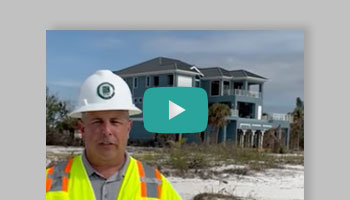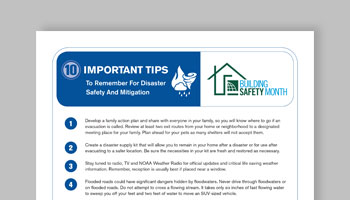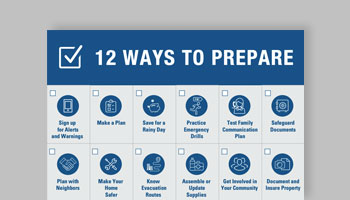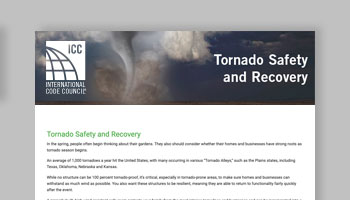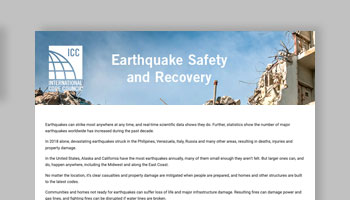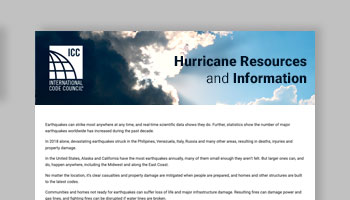Week 3 of Building Safety Month 2023 focuses on how to protect your home and your community from disaster. Read on to learn more about how building codes help to protect us against flooding, earthquakes, hurricanes and wildfire events. You’ll also learn how to plan to help limit damage to buildings in your community.
How Codes Protect Against Disaster

According to the Federal Emergency Management Agency (FEMA), one of the most cost-effective ways to safeguard our citizens and our communities against disasters is to adopt and follow hazard-resistant building codes. When adopted and enforced, building codes can save lives, save billions of dollars and protect property for generations to come. Here are a few facts to consider:
- Since 1980, the average number of billion-dollar disasters has been six per year, but from 2016 to 2018, the number jumped to 15 per year.
- A staggering 65 percent of counties, cities and towns across the U.S. have not adopted modern building codes.
- Only 27 percent of hazard-prone jurisdictions in the U.S. adopted the latest two editions of hazard-resistant building codes.
- The I-Codes could help communities avoid $132 billion to $171 billion in cumulative losses through 2040.
- If all new buildings across the U.S. were built to modern editions of the I-Codes, the country would save more than $600 billion by 2060.
Disaster Preparedness

Having an evacuation and communication plan in place and an emergency supply kit on hand can help protect you and your loved ones. Review these simple, life-saving tips and visit Ready.gov for specific tips on dealing with earthquakes, extreme heat, floods, home fires, hurricanes, tornados, wildfires and more.
- Develop a family action plan and share with everyone in your family, so you will know where to go if an evacuation is called.
- Review at least two exit routes from your home or neighborhood to a designated meeting place for your family.
- Create a disaster supply kit that will allow you to remain in your home after a disaster or for use after evacuating to a safer location. Be sure the necessities in your kit are fresh and restored as necessary.
- Stay tuned to radio, TV and NOAA Weather Radio for official updates and critical lifesaving weather information. Remember, reception is usually best if placed near a window.
Hazard Mitigation

Hazard mitigation is a defensive approach that reduces long-term risk to people and property from future disasters. According to Climate.gov, the impacts of climate-related hazards are already occurring, and they are projected to worsen in many regions around the world. Here are a few tips to consider before the next hazardous event:
- Visit Climate.gov to check how your exposure to five common climate-related hazards is projected to change over time.
- For earthquakes, start by anchoring or relocating top-heavy or large objects, securing fixtures, electronics and water heaters, keeping a clear path to the exit and latching your cabinets.
- For flooding, store valuables in waterproof containers, floodproof basements, elevate utilities above the BFE, install flood vents and use flood-resistant insulation and drywall.
- For wildfires, construct your roof with fire-resistant materials, create 30 feet of defensible space around your home, remove debris from roof and gutters and seal gaps around exterior walls and roof.
- For severe winds from tornados or hurricanes, protect windows and glass doors with storm shutters, reinforce garage doors, fortify your roof and remove rotting trees and limbs.
The Code Council in Action

- Fire-Resistant Construction in the Wildland Urban Interface
- ICC Pulse Podcast Episode 47 - Living with Fire: How Wildland-Urban Interface Fires Impact Everyone
- Codes Save: Up-To-Date Building Codes Support Safe, Sustainable and Resilient Communities
- Building Codes Support Disaster Preparedness and Resilience
- ICC Pulse Podcast Episode 37 - FEMA’s Building Codes Save: A Nationwide Study
- International Code Council Resilience Toolkit
- Building Codes Adoption Playbook
- Building Performance Standards Guide
- Clean Energy Clearinghouse
- Four Steps to Using Building Codes to Mitigate the Impact of Disasters
Spread the Word








